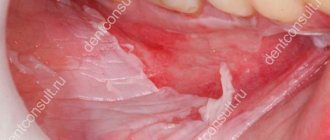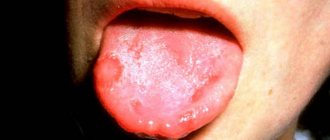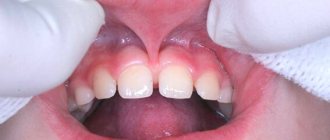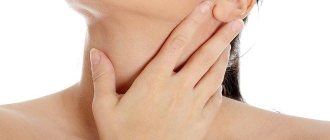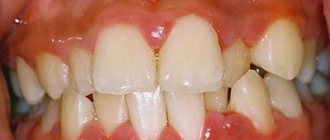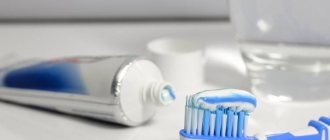Pimples on the tongue - what are they?
The mucous membrane in the mouth and tongue does not have sebaceous glands, so typical pimples cannot form on it. Such formations have two formation mechanisms:
- Under the influence of damaging factors, viruses or bacteria, the mucous membrane stratifies, under the top layer of which liquid accumulates and small bubbles form. If such a formation is not infected, then its contents will be transparent, but if infection has penetrated into its cavity, then suppuration is possible - the vesicle will turn white. If blood gets into the liquid, then this formation takes on a red or dark tint. The blisters may burst and painful ulcers form in their place.
- Sometimes, in response to inflammation, cells on the surface of the tongue begin to actively divide and slough off. Whitish or red formations form that resemble ordinary pimples, but at the same time they are only enlarged papillae.
Treatment of urticaria
The only way to get rid of the disease is to avoid contact with the allergen, which is previously detected by laboratory tests.
If testing does not reveal a provoking factor, and the urticaria is episodic, then taking antihistamines will quickly eliminate the symptoms. During treatment, it is recommended to follow a diet that, in case of urticaria, will help prevent the recurrence of the disease. The menu should include only hypoallergenic products: lean boiled meat, soups with recycled meat broth or vegetarian. It is better to choose rice, buckwheat, and oatmeal from cereals. Low-fat cottage cheese, natural yogurt, apples, dried fruit compote, excluding raisins, and whole grain bread are recommended.
Citrus fruits, nuts, fish and all seafood, chocolate products, smoked meats, coffee, eggs, honey, and store-bought baked goods should be excluded from the menu during treatment.
Treatment is carried out by a dermatologist and an allergist-immunologist. For topical application, ointments for urticaria are effective; they not only relieve itching, but also eliminate swelling, redness and a burning sensation on the skin. One of the most effective is Dimetinden gel, which must be applied in a thin layer to the affected area of the skin up to 4 times a day.
A course of antihistamines is prescribed in the form of tablets. Your doctor may also prescribe calcium gluconate or calcium chloride for urticaria. They help reduce the symptoms of allergies, but they should only be administered under the supervision of a doctor in the treatment room.
If antihistamines do not provide the desired effect quickly, or for severe forms of hives, corticosteroids are used, which can be applied to the skin or taken in the form of tablets or injections.
Causes of pimples
There are many reasons for the appearance of such formations on a child’s tongue. Let's try to understand each of them in more detail.
Tongue injuries
After three months of age, babies begin to actively explore the world around them, including trying to taste everything. But the objects that enter the child’s mouth are not always sterile. Older children often have a habit of chewing on sharp objects, which can also scratch or injure the tongue. Even minor trauma to the mucous membranes in combination with the ingress of microbes can provoke an inflammatory reaction and the appearance of painful pimples, which are often localized on the tip of the tongue.
Candidiasis or thrush
In children under one year of age, the immune system is not fully formed, so any disease leads to a decrease in the body’s protective properties. The consequence of this is candidiasis in the oral cavity - active growth of fungi of the genus Candida on the mucous membranes, which can also be provoked by taking antibiotics. One of the typical manifestations of thrush is the appearance of pimples and a cheesy white coating on the entire tongue surface, spreading to the entire oral cavity. If you remove such plaque, you can find redness, swelling and even the appearance of small ulcers underneath it.
Stomatitis
With stomatitis, a large number of small white pimples appear on the root of the tongue at its base, on its lateral surfaces or at the tip, which are very painful and cause discomfort while eating or talking. Such pimples can merge to form extensive ulcers. In severe cases, the child feels generally unwell and has a high body temperature.
Allergy
Children under two years of age are more likely than adults to have allergic reactions. One of the manifestations of allergies is the appearance of small whitish or red pimples on the tongue. They can be located both at the tip and in the area of the root of the tongue and move to other parts of the oral mucosa: lips, gums, palate. Most often, such formations bother the child, itch and cause pain when eating and swallowing. But this is not characterized by an increase in body temperature.
An increase in allergy symptoms and the appearance of new pimples is caused by eating a product to which you are hypersensitive. Often the cause of such allergic reactions is toothpaste or other oral care products, even if they are recommended for use in children.
Angina
A bacterial infection that affects the tonsils in children can also spread to the lymphoid tissue, which is located at the root of the tongue closer to the throat. This is accompanied by the appearance of white pimples with a purulent coating in the tongue area. When the pus is removed, areas of redness and slight swelling are exposed. The formations are painful, interfere with normal swallowing and significantly worsen the child’s well-being: he becomes capricious, refuses to eat, and his body temperature rises. Often, if there are such pimples near the throat, you can feel enlarged lymph nodes.
Herpetic infection
Infection with the herpes virus most often occurs in childhood, and when the body’s immune defense is reduced, the infection can worsen. In this case, watery small pimples on a red background appear on the tongue, which can also appear on the child’s lips and throat. They are very painful and after opening them, shallow ulcers appear, which prevent the child from eating and talking normally.
Dysbacteriosis and unbalanced nutrition
Errors in the nutrition of a child, especially of a younger age, as well as disturbances in the normal composition of the intestinal microflora can lead to glossitis - inflammation of the mucous membrane of the tongue. This leads to the fact that the epithelium of the papillae begins to actively divide, they take on the appearance of inflamed red or whitish pimples. They rarely bother the child; sensitivity to hot, cold or sour foods may only change.
How is diagnosis and treatment carried out?
To cure a rash on a child’s tongue, it is dangerous to self-medicate - after all, you first need to identify the true cause of the disease. Therefore, the first thing you should do is contact a pediatric dentist or pediatrician (if the child is very small) and undergo the appropriate tests - PCR blood diagnostics or tongue scraping.
Next, the drug is prescribed in accordance with the goal that needs to be achieved during treatment:
- for pain relief: for example, ibuprofen-based drugs,
- to relieve swelling and allergic manifestations: antihistamines are shown here - “Suprastin” or “Zodak”,
- to neutralize the pathogen: antibiotics are prescribed for bacterial inflammation. If the herpes virus is “to blame,” then antiviral drugs (“Acyclovir”) are used; in case of fungal infection, “Nystatin” or “Fluconazole” are used.
- Regenerative drugs are prescribed for tissue restoration.
To strengthen the body, a course of fortification and proper nutrition are prescribed. Until the negative symptoms are completely relieved, the child should not eat dry, hard, sour or spicy foods. You should also exclude very hot and cold foods. Food should be warm and soft (can be mashed with a fork or blender) so as not to further injure the inflamed areas in the mouth.
Treatment
In the treatment of pimples on the tongue, regardless of the reasons that caused their appearance, there are common points:
- Mandatory thorough oral hygiene. After each meal, it is advisable to treat pimples with an antiseptic solution.
- Excluding any irritating factors from the child’s diet: spicy, hot or sour foods. It is desirable that the food is soft and does not cause additional injury to the mucous membrane.
- Under no circumstances should pimples be squeezed or opened; this can lead to the development of complications in the child and aggravation of his condition.
- Dr. Komarovsky recommends in such cases drinking a large amount of liquid, which will help remove toxins and allergens from the child’s body.
If pimples cause pain and discomfort in a child, then the doctor may prescribe products for topical use with an analgesic and anti-inflammatory effect (Solcoseryl, Metrogyl denta).
If the cause of pimples is a sore throat or stomatitis, then it may be recommended to take antibacterial agents in combination with antiseptics. Treatment of allergic manifestations consists of eliminating the action of the allergen and taking antiallergic medications. For herpetic lesions of the mucous membranes of the tongue, antiviral drugs have a good effect, and for candidiasis - drugs with antifungal action.
Before you begin to treat pimples that appear on the tongue, you need to find out the causes of their occurrence. It is from this moment that all further treatment measures will depend. In order to make a correct diagnosis, you need to visit a dentist. Self-medication can be dangerous for the child.
First aid for hives
It is important that you always have allergy medications in your home medicine cabinet, since urticaria in adults, and in children too, can appear at any time.
Allergy medications can be in the form of drops or tablets. Modern remedies do not cause drowsiness and have virtually no side effects. Doctors recommend having in your home medicine cabinet to eliminate urticaria and itching, Fenistil drops, which can be used from childhood, Erius tablets, which have a long-lasting antihistamine effect after administration, Loratadine, which helps cope with Quincke's edema, which often accompanies urticaria.
It is important to take the medicine at the first symptoms, without waiting for the general condition to worsen. If after 20 minutes from the moment of administration there is no improvement, you should call an ambulance.
Symptoms and mechanisms of development of urticaria
The appearance of the main symptoms of urticaria - blisters and redness - is associated with the mechanism of development of the disease. This is an increase in vascular permeability and acute swelling in the tissues that surround the vessels.
The mast cell plays a leading role in the development of urticaria. These are special immune cells, the granules of which contain special biologically active substances (mediators). The most studied of them is histamine. It is because of its action that the symptoms of urticaria arise - rashes, redness, swelling, itching.
A blistering rash appears suddenly on any part of the body, disappears quickly and without a trace within 24 hours, and then appears elsewhere. When you press on the center of the redness, a white spot is visible.
The itching begins at the same time as the rash. This is how histamine acts on nerve endings.
Depending on the factor that activated the release of histamine from mast cell granules, different types of urticaria are distinguished.
In children with urticaria, there may be a deterioration in their general condition: increased body temperature, disruption of the digestive system (diarrhea).
3.Diagnosis of the disease
The diagnosis of urticaria or Quincke's edema is made after examination. Your doctor will ask you a few questions to find out the possible cause of your hives or angioedema and examine your skin. Depending on your health condition, you may need to consult an allergist, immunologist or dermatologist.
Skin tests may be done to determine which substance is causing your allergy. And routine blood tests are needed to determine the presence of some systemic disease.
About our clinic Chistye Prudy metro station Medintercom page!
4.How to treat urticaria and Quincke's edema?
The easiest way to deal with urticaria and angioedema is if you can identify and eliminate the factor that caused the problem. But this is not always possible. Typically, antihistamines are used to treat hives. They will help relieve the symptoms of the disease. Sometimes antihistamine medications need to be taken regularly to prevent the rash and associated swelling.
Chronic urticaria is treated with antihistamines or a combination of them. But if this does not give the desired result, sometimes the doctor prescribes corticosteroids.
In severe cases of urticaria and angioedema, an injection of adrenaline or steroid medications may be necessary.
What else can be done to treat hives?
While the course of treatment is ongoing and you are waiting for the redness and swelling to disappear, follow these simple recommendations.
- Do not use hot water. Let it just be warm.
- Wash with mild soap.
- You can apply cold compresses or apply a damp cloth to the affected areas.
- Be in a cool room.
- Wear loose, lightweight clothing.
When and which doctor to contact
Usually a doctor is consulted:
- if the rash spreads over a large area;
- when symptoms increase;
- when signs of general intoxication occur;
- if the urticaria does not go away on its own after eliminating the factor that caused it;
- if the disease becomes chronic or often recurs,
It is advisable not to delay your visit to the doctor and come when the first manifestations of the disease occur. Then it will be easier to establish the cause, and treatment will take less time. In addition, the doctor will recommend what to do to prevent hives.
A therapist or pediatrician, a dermatologist can provide assistance with urticaria, and an allergist is involved in targeted diagnosis and treatment.
